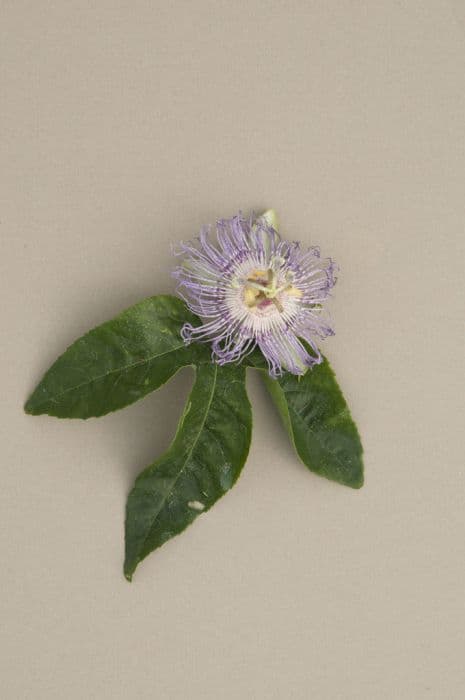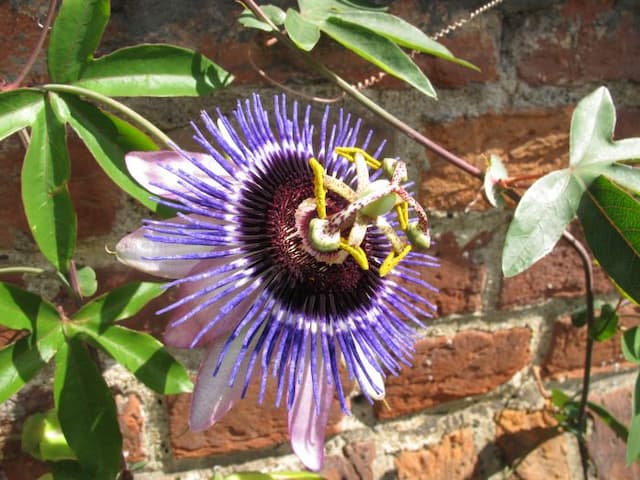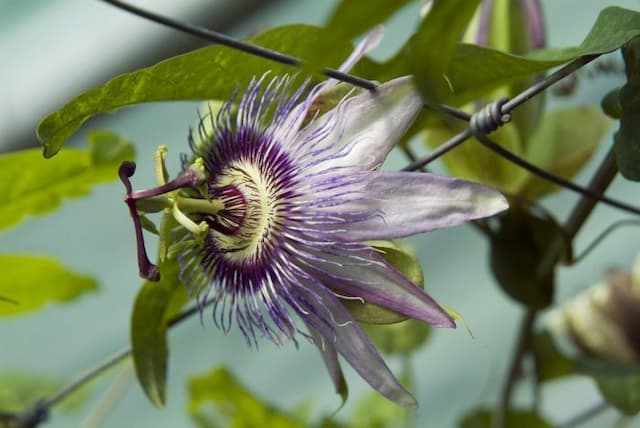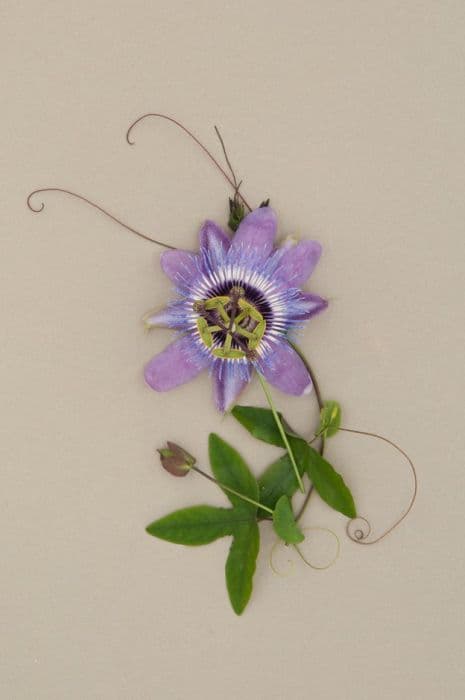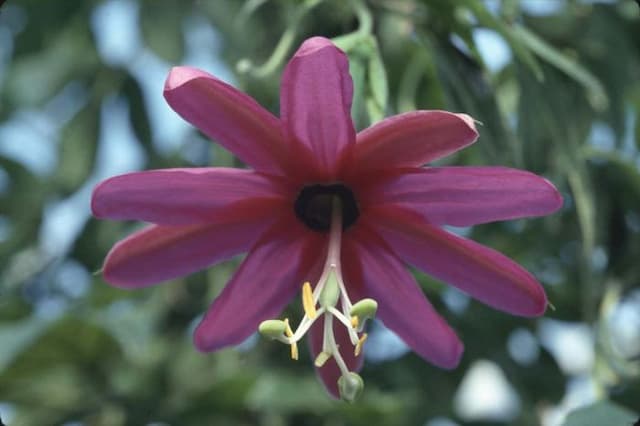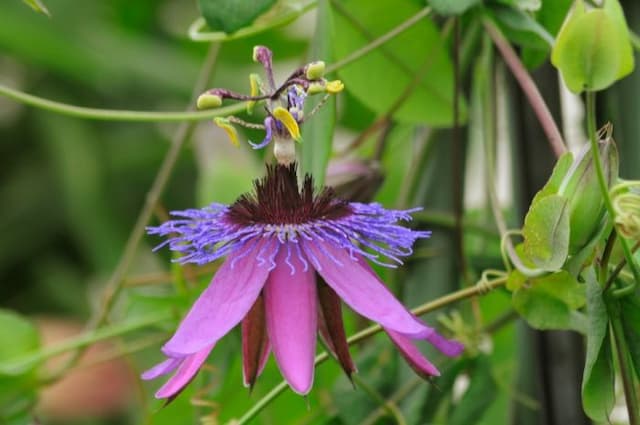Sweet Granadilla Passiflora ligularis (F)






ABOUT
Passiflora ligularis, commonly known as the sweet granadilla, bears a striking appearance with a combination of unique features. The plant is a vine, which showcases distinctive, three-lobed dark green leaves that have a glossy texture. In addition to its foliage, the sweet granadilla produces remarkable flowers. These flowers have a set of filamentous structures which radiate from its center, forming a corona. The colors of the blossom encompass shades of pink, purple, and white, creating a striking contrast against the greenery. The most stand-out feature of the sweet granadilla is its fruit. The fruit has a round to oval shape and is crowned at the apex where the flower was once attached. Its skin is hard and inedible, usually orange to yellow when ripe, with a pithy layer under the surface. Inside, the sweet granadilla reveals a cavity filled with black seeds, each one encased in a transparent, gelatinous sack. The interior of the fruit is a greyish to deep orange color, and the seeds paired with the pulp offer a sweet and tart flavor which is highly valued in culinary applications. While the sweet granadilla is a vine that climbs and sprawls with the use of tendrils, specific details regarding the extent of its growth are omitted. Overall, the beauty of the sweet granadilla lies in its striking flowers, unique fruit, and luscious foliage, which make it an attractive plant both for ornamental purposes and for its delicious fruit.
About this plant
 Names
NamesSynonyms
Sweet Granadilla, Granadilla, Grenadia, Honey Passionfruit, Passionfruit, Conch Apple, Sugar Fruit.
Common names
Passiflora tripartita var. mollissima, Tacsonia mollissima, Passiflora tripartita subsp. mollissima, Tacsonia sphaerocarpa, Tacsonia coccinea, Tacsonia nigra, Passiflora pittieri, Passiflora lindeniana, Tacsonia lindeniana, Passiflora tica, Passiflora mixta, Passiflora macrophylla, Passiflora durangina
 Toxicity
ToxicityTo humans
Passiflora ligularis, commonly known as sweet granadilla, is not typically considered toxic to humans. In general, the fruit is edible and often consumed for its sweet taste. However, as with any food item, some individuals might be allergic to this fruit. If someone has an allergy to sweet granadilla, they may experience symptoms like itching, hives, swelling, difficulty breathing, or anaphylaxis. It is important to eat this fruit in moderation, as overconsumption of any fruit can lead to digestive discomfort. Moreover, the plant's leaves and unripe fruits contain cyanogenic glycosides, which can release cyanide when metabolized. This can potentially lead to cyanide poisoning, with symptoms including nausea, vomiting, dizziness, headaches, and in severe cases, respiratory failure and death. However, such cases are rare, and this plant is generally regarded as a safe, edible species when the ripe fruit is eaten.
To pets
Passiflora ligularis, known as sweet granadilla, is not commonly toxic to pets. The ripe fruit of this plant is generally considered safe for animal consumption. However, it is essential to be cautious as the leaves and stems can contain cyanogenic glycosides, which can be toxic if ingested in large quantities. If a pet consumes a significant amount of the plant's leaves or stems, symptoms might include vomiting, diarrhea, abdominal pain, difficulty breathing, and in severe cases, seizures or coma. It is advised to keep pets away from the non-fruit parts of the plant and to consult with a veterinarian if ingestion occurs and adverse symptoms are observed.
 Characteristics
CharacteristicsLife cycle
Perennials
Foliage type
Evergreen
Color of leaves
Green
Flower color
White
Height
10 feet (3 meters)
Spread
6 feet (1.8 meters)
Plant type
Climber
Hardiness zones
9
Native area
Americas
Benefits
 General Benefits
General Benefits- Nutritional Value: The fruit of Passiflora ligularis, commonly known as sweet granadilla, is rich in vitamins A and C, fiber, and minerals, making it a nutritious addition to the diet.
- Culinary Uses: Sweet granadilla can be eaten fresh or used in desserts, salads, drinks, and jams, offering a variety of uses in cooking and gastronomy.
- Ornamental Plant: With its attractive flowers and climbing habit, Passiflora ligularis is often grown as an ornamental plant, enhancing garden aesthetics.
- Shade Provider: As a climbing vine, sweet granadilla can be used to create natural shade over pergolas or other garden structures.
- Pollinator Attraction: The flowers of Passiflora ligularis attract various pollinators like bees and butterflies, supporting biodiversity.
- Edible Landscaping: Sweet granadilla can be incorporated into edible landscaping, contributing both aesthetic appeal and edible fruits to the garden design.
- Economic Value: Sweet granadilla is commercially cultivated for its fruit, which has economic value in local and international markets.
- Cultural Significance: In many regions where it is grown, sweet granadilla has cultural importance and is used in traditional festive dishes and celebrations.
 Medical Properties
Medical Properties- Traditional sedative: Passiflora ligularis, commonly known as sweet granadilla, has been used in traditional medicine as a sedative.
- Anxiety relief: The fruit is sometimes utilized for its potential calming effects, which may help alleviate symptoms of anxiety.
- Insomnia remedy: In folk medicine practices, sweet granadilla is often employed to aid sleep and manage insomnia.
- Antioxidant content: The fruit possesses antioxidants, which are believed to protect the body from oxidative stress and may support overall health.
 Air-purifying Qualities
Air-purifying QualitiesThis plant is not specifically known for air purifying qualities.
 Other Uses
Other Uses- As a natural dye: The fruit juice of Passiflora ligularis, more commonly known as sweet granadilla, can be used as a natural dye for fabrics, providing a light greenish or yellowish hue.
- Hair conditioner: The pulp of sweet granadilla can be used as a natural hair conditioner to add moisture and shine to the hair.
- Flavor enhancer: The aromatic seeds and pulp can be used to enhance the flavor of desserts and beverages with its tropical essence.
- Garden ornamental: With its climbing nature and attractive flowers, sweet granadilla can be cultivated as an ornamental plant to add beauty to gardens and attract pollinators.
- Compost enrichment: The fruit peels and leftover pulp can be added to compost piles to enrich the nutrient content of the compost.
- Natural insect repellent: Some people believe that the leaves of sweet granadilla can be used as a natural insect repellent when crushed and placed around outdoor living areas.
- Educational tool: The complex structure of the plant's flowers can be used to teach about plant biology and pollination in educational settings.
- Traditional crafts: The dried seeds are sometimes used in creating jewelry or decorative items as part of local traditional crafts.
- Food presentation: The hollowed-out shell of the fruit can be used as an elegant, natural bowl for serving tropical salads or desserts.
- Bird feeder: After consuming the fruit, the empty shell can be filled with bird feed to attract and feed birds in your garden.
Interesting Facts
 Feng Shui
Feng ShuiThe Sweet Granadilla is not used in Feng Shui practice.
 Zodiac Sign Compitability
Zodiac Sign CompitabilityThe Sweet Granadilla is not used in astrology practice.
 Plant Symbolism
Plant Symbolism- Passion: As a member of the Passiflora genus, the Passiflora ligularis, commonly known as the sweet granadilla, is often associated with the themes of the passion of Christ due to the resemblance of its parts to religious symbols like the crown of thorns and the crucifixion wounds.
- Spiritual Enlightenment: The complex structure of the sweet granadilla flower is frequently symbolic of mystery and the search for meaning, leading to it being linked to concepts of spirituality and enlightenment.
- Peace: The serene appearance and calming presence of the Passiflora ligularis can symbolize peace and tranquility, making it a common plant in gardens that are designed for meditation and relaxation.
- Exotic Beauty: The unique and striking appearance of the sweet granadilla suggests ideas of exotic beauty and allure, often representing the beauty found in diversity and the unusual.
 Water
WaterFor the sweet granadilla, it's crucial to maintain a consistently moist soil environment without causing waterlogging. Water the plant thoroughly once the top inch of soil feels dry, which may be once a week or more frequently during hot, dry periods. Depending on the size of the plant and the environmental conditions, a general guideline is to provide approximately half a gallon of water at each watering. During winter or cooler months, reduce the frequency to every other week or when the soil dries out more significantly, as the plant's water requirements diminish.
 Light
LightSweet granadilla plants thrive in bright, indirect light or dappled sunlight. They should be placed in a spot where they can receive several hours of morning sunlight but are protected from the harsh afternoon sun. East or west-facing locations that offer sunlight for at least half the day are generally suitable for promoting healthy growth.
 Temperature
TemperatureSweet granadilla prefers a warm climate, with ideal temperatures ranging between 68°F to 86°F. This plant can handle minimum temperatures of around 50°F but should not be exposed to frost. It's essential to keep sweet granadilla away from freezing temperatures and to maintain a warm environment for optimal growth.
 Pruning
PruningPrune sweet granadilla to maintain shape, remove dead or damaged growth, and encourage healthy fruit production. The best time for pruning is in early spring, just before the growing season begins. Prune lightly, cutting back overgrown branches and selectively thinning out dense areas to improve air circulation. Perform pruning annually or as needed to keep the plant manageable.
 Cleaning
CleaningAs needed
 Soil
SoilSweet granadilla thrives in well-draining soil with a mixture of peat, perlite, and compost. The ideal pH for this plant is between 6.5 and 7.5. A nutrient-rich loamy soil enriched with organic matter will support healthy growth.
 Repotting
RepottingSweet granadilla should be repotted every two to three years, or when the plant outgrows its current pot. Repot in spring or early summer to minimize stress on the plant.
 Humidity & Misting
Humidity & MistingSweet granadilla prefers high humidity levels, ideally between 50-70%. Maintain humidity by misting regularly or using a humidifier.
 Suitable locations
Suitable locationsIndoor
Allow bright indirect light, ensure high humidity, and avoid cold drafts.
Outdoor
Place in partial shade, protect from strong winds, ensure soil drainage.
Hardiness zone
9-11 USDA
 Life cycle
Life cyclePassiflora ligularis, commonly known as the Sweet Granadilla, begins its life cycle with seed germination, which occurs under warm, moist conditions, often in the spring. The seeds grow into vines that require support and can rapidly climb using their tendrils. These vines produce dark green, lobed leaves, and the plant develops unique, fragrant flowers which have a complex structure typical of the passionflower family. Following pollination, which can be aided by bees or hummingbirds, the flowers give way to the fruiting stage, where the distinctive round or oval fruits with a tough rind and sweet, seedy pulp mature. The fruits typically ripen until they achieve a yellow to orange hue, at which point they can be harvested. After fruiting, if the conditions are not favorable, or at the end of the growing season, the plant may enter a period of dormancy, particularly in regions with cooler temperatures, before resuming growth in the next cycle.
 Propogation
PropogationPropogation time
Spring-Early Summer
Propogation: The most popular method of propagation for the Sweet Granadilla, which is the common name for Passiflora ligularis, is through seeds. It is best to collect seeds from a ripe fruit to ensure they are mature. The propagation time is typically during the warm months, as seeds need a temperature range between 68 to 77 degrees Fahrenheit (20-25 degrees Celsius) to germinate effectively. After extracting the seeds from the pulp, it's advisable to wash and dry them. Sowing the seeds can be done in pots or directly in the ground, covering them with a thin layer of soil. Consistent moisture should be maintained until germination occurs, which can take anywhere from two to four weeks. Once the seedlings are sturdy enough, they can be transplanted to their final growing location.

